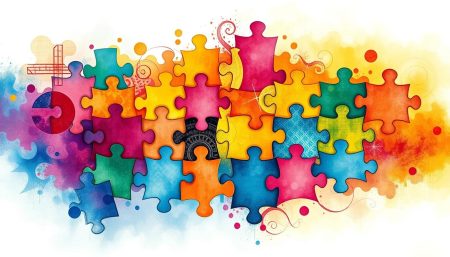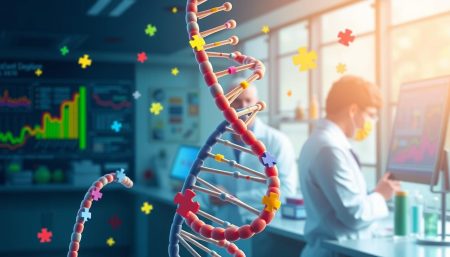To define autism spectrum disorder (ASD) is to understand a complex condition. It often includes challenges with social skills, repetitive behaviors, speech, and nonverbal communication. ASD affects people differently, making it important for everyone to understand it.
Explaining autism spectrum disorder clearly helps us grasp its many aspects. From early views of autism to today’s research and treatments, this article offers valuable insights. It aims to give readers a deeper understanding of ASD.
We will look at many parts of autism, like how it’s diagnosed and treated. We’ll also talk about how more people knowing about ASD can help. Each part is designed to give a complete view of ASD. This way, readers will have a strong base for understanding its impact on people and communities.
Introducing Autism Spectrum Disorder
Autism Spectrum Disorder, or ASD, is a group of conditions that affect how people interact and communicate. This section will help you understand what is ASD and the different spectrum of autism conditions. We aim to give you a deeper look into autism, beyond just a simple autism definition.
What is ASD: More Than a Definition
What is ASD? It’s a complex condition with challenges in social interaction, communication, and repetitive behaviors. But, it’s more than that. It also includes a wide range of strengths and abilities, making each case of autism unique.
The Spectrum: A Range of Conditions and Abilities
The term “spectrum” in spectrum of autism conditions is key. It shows how different people with ASD can be. The spectrum includes those who live relatively independent lives and those who need a lot of daily support. Here, we’ll look at the main categories in the spectrum:
| Category | Characteristics | Support Needs |
|---|---|---|
| High Functioning Autism | Mild symptoms that might not hinder intelligence or verbal skills. | Minimal support; emphasis on social skills development. |
| Asperger’s Syndrome | Characterized by difficulties in social interaction despite normal to high intelligence. | Social skills training and cognitive behavioral therapy. |
| Classic Autism | More pronounced symptoms including intellectual challenges. | Comprehensive, ongoing support in multiple areas. |
| Pervasive Developmental Disorder-Not Specified (PDD-NOS) | Significant variability in symptoms; does not fully fit into other categories. | Flexible and tailored support based on individual needs. |
Understanding the spectrum of autism conditions helps us see that each person is unique. This table gives a quick overview of the spectrum. It encourages us to understand and support each person in their own way.
The History and Evolution of Autism Diagnosis
The journey of ASD diagnosis has seen big changes from its first descriptions to today’s criteria. Understanding the evolution of autism understanding shows us how complex diagnosing and treating this condition is.
At first, autism was mixed up with other mental health issues. This was because of limited understanding at the time. As we learned more, our way of diagnosing ASD changed. This shift helped create better support for those on the spectrum.
- Early 20th Century: First clinical accounts of autism, heavily influenced by the work of psychiatrists like Leo Kanner.
- Mid-20th Century: Shift from psychodynamic explanations to more clinical and behavioral understandings.
- Late 20th Century: Introduction of autism in the DSM-III, recognizing it officially as a distinct diagnosis.
- 21st Century: Refined diagnostic criteria in the DSM-5, highlighting the spectrum nature of autism and acknowledging varying levels of severity and manifestations.
This timeline shows the big steps forward in ASD diagnosis and how our understanding of autism has grown. As we learn more about ASD, we can offer more accurate and caring care to those affected.
Define Autism Spectrum Disorder
To define autism spectrum disorder well, we must look at how it’s seen in the medical world. Autism spectrum disorder (ASD) is a group of conditions. They make social skills, speech, and communication hard. The Centers for Disease Control says 1 in 54 kids in the U.S. have ASD.
ASD in the Medical Community: An Overview
How doctors diagnose ASD has changed a lot. But, it’s always being studied to get better at defining and treating it. This shows we’re getting a deeper understanding of its many forms.
Core Symptoms of Autism
The core symptoms of autism include trouble with social communication and interaction. People with autism also have repetitive behaviors. These issues can make everyday life hard.
- Difficulty in understanding social cues
- Limited use of language for social communication
- Engagement in repetitive behaviors such as hand-flapping, rocking, or spinning
- Unusual responses to sensory inputs like adverse reactions to specific sounds or touches
Knowing these symptoms is key to helping those with ASD. It helps improve their life quality a lot.
Examining the Causes of ASD
Autism Spectrum Disorder (ASD) comes from a mix of genetic and environmental factors. This part looks at what causes ASD, aiming to help us understand and treat it better.
Genetic Factors Influencing Autism
Research on genetic factors in autism has grown a lot. Studies show that genetic changes, both inherited and new, are key in autism. But, it’s not one gene causing autism alone. It’s the mix of many genes that increases the risk.
Environmental Triggers and Their Role
Looking into environmental triggers adds more to understanding ASD. Things like certain chemicals, health issues in the mother during pregnancy, and stress in early childhood might play a part. They could work together with genetic risks to cause ASD.
| Genetic Factors | Environmental Triggers |
|---|---|
|
|

Characteristics of Autism in Early Childhood
Spotting the characteristics of autism in young children is key for early help. This part talks about the early signs of ASD and how they link to developmental milestones. It helps parents and caregivers understand better.
Recognizing Early Signs and Behaviors
Autism Spectrum Disorder shows up in many ways in early childhood. It can affect how a child talks, interacts, and acts. Signs include not making eye contact, not talking when they should, and not wanting to play with others.
Developmental Milestones and Autism
It’s important to watch developmental milestones because not meeting them can mean ASD. These milestones cover physical, thinking, and social-emotional growth. If a child is way behind their friends in these areas, it might be time to check for autism.
| Age | Expected Milestone | Common Signs of ASD |
|---|---|---|
| 6 Months | Responds to name | No response to name, lack of eye contact |
| 1 Year | Babbling or baby talk | Limited or no babbling |
| 2 Years | Two-word phrases | Does not combine words |
| 3 Years | Plays with peers | Prefers playing alone, little interest in others |
Knowing about characteristics of autism in young kids helps with early diagnosis and treatment. It’s vital for parents to watch their child’s growth and talk to doctors if they see early signs of ASD.
Autism Definition: Expanding Beyond Childhood
Understanding autism is key, and it’s a lifelong condition. It affects people of all ages, not just kids. This part talks about adult autism and the ongoing journey of those with it.
Adult Autism: Symptoms and Diagnosis
Spotting adult autism can be tough. Symptoms in adults are often less obvious than in kids. They might struggle with social interactions, emotions, and work.
Diagnosing adults needs a special approach. The usual tests are made for kids, not adults.
Living with Autism: A Lifelong Journey
Autism is a lifelong journey that changes with age. Adults with autism face unique challenges and chances for growth. Each person’s experience is different.
This journey shows resilience and adaptability. People with autism create their own paths with help from resources, therapy, and community support. It’s important to understand adult autism to help everyone live a fulfilling life.
Expanding the autism definition to include all ages helps society accept it more. It leads to better support systems for those affected. Recognizing the lifelong journey of autism opens the door to more effective help and a more inclusive view of autism.
Perspectives on ASD Diagnosis Criteria
The ASD diagnosis criteria have greatly influenced how we see and treat ASD. Doctors, researchers, and people with ASD have different views on these criteria. Their opinions shape how we diagnose and care for ASD.
One big issue is how the ASD diagnosis criteria change with age. Kids are diagnosed based on their behavior, which is different from adults. This makes it hard to spot ASD early and manage it over time. We need a single set of rules that works for everyone, no matter their age.
- Consistency across age groups
- Integration of recent research findings
- Consideration of cultural and socio-economic factors
It’s also important to update the criteria regularly. New research and findings should guide these changes. This way, we can make sure the criteria are up-to-date and accurate.
Listening to people with ASD can also help improve the criteria. Their experiences can give us valuable insights. By using their feedback, we can make the criteria more practical and effective.
Understanding ASD diagnosis is complex. It requires a broad approach that values different views. If you’re interested in learning more, check out this test for antisocial personality disorder. It shows how important accurate diagnosis and early detection are.
In conclusion, broadening the ASD diagnosis criteria is key. It helps us better understand ASD and ensures everyone gets the right support and care.
Approaches to ASD Management and Support
Managing Autism Spectrum Disorder (ASD) involves many strategies. These are tailored to meet individual needs. Behavioral interventions and autism educational support are key in helping those with ASD.
Behavioral and Educational Interventions
Behavioral interventions are vital in ASD management. They help reduce challenging behaviors and teach new skills. Specialized educational programs are also important. They are designed to meet the unique learning needs of autistic individuals.
- Tailored educational curricula that incorporate visual aids and structured learning sessions.
- One-on-one support from educators trained in ASD, focusing on engagement and interaction.
- Use of technologies like computer-assisted learning and virtual reality to improve skills.
Family Support and Resources
Support for families is essential in managing autism. Resources, education, and emotional support empower families. They also strengthen the support network needed for long-term management.
- Access to support groups and forums for sharing experiences and solutions.
- Workshops and seminars to educate families about ASD and management techniques.
- Provision of respite services to give caregivers temporary relief, promoting wellbeing.
In conclusion, effective ASD management needs a mix of specialized education and behavioral interventions. Strong family support is also critical. Advances in education and resources show a commitment to improving life for those with autism and their families.
Challenges Faced by Individuals with ASD
People with Autism Spectrum Disorder (ASD) face many challenges. These affect their social integration and job success. We will look at the challenges of autism, focusing on social integration and job opportunities.
Social Integration and Workplace Opportunities
Many with ASD struggle with social integration. They find it hard to communicate, understand social cues, and manage anxiety. These issues make it tough for them to find and keep jobs.
Yet, businesses are starting to see the strengths of people with ASD. They bring attention to detail and strong analytical skills. Efforts are being made to create jobs that fit their abilities.
Coping Strategies for Families
Families are key in supporting those with ASD. They use various strategies to cope with autism’s challenges. Here are some ways families help navigate these issues.
- Educational planning and support: Ensuring access to specialized education programs tailored to the needs of their child.
- Routine-based support: Establishing consistent daily routines to help individuals with ASD feel secure and reduce anxiety.
- Professional counseling: Engaging with therapists who specialize in ASD can provide coping strategies tailored to individual needs.
| Challenge | Impact on Individual | Strategy |
|---|---|---|
| Social Communication | Difficulty in verbal and non-verbal communication affects personal and professional relationships. | Use of social stories and visual aids to improve understanding. |
| Behavioral Challenges | May lead to social isolation and misunderstanding by peers. | Behavioral therapy and consistent routine setups. |
| Workplace Integration | Struggles with typical work environments can limit career opportunities. | Work environments designed to suit sensory and social preferences. |
Understanding Treatment Options for ASD
In this section, we explore a variety of treatment options for ASD. We look at both traditional and innovative approaches. It’s key to understand these options for creating effective care plans.
Medication, Therapies, and Alternative Treatments
The world of autism therapies is wide and varied. It includes many methods that help manage symptoms and improve life quality. We’ll cover these methods, from medicines to non-medical treatments.
- Medications like Risperidone and Aripiprazole for irritability
- Behavioral therapies such as Applied Behavior Analysis (ABA)
- Dietary and nutritional adjustments
- Occupational therapy focused on skill-building
- Speech therapy to enhance communication abilities
Evidence-Based Practices in Autism Care
Evidence-based autism care focuses on methods backed by scientific research. These practices are key for ensuring the best, safest, and most fitting treatments for ASD.
| Therapy Type | Goals | Expected Outcomes |
|---|---|---|
| ABA (Applied Behavior Analysis) | Develop social skills, reduce problem behaviors | Improved social interaction, reduced disruptions |
| Sensory Integration Therapy | Help individuals manage sensory differences | Better coping with sensory stimuli |
| Cognitive Behavioral Therapy (CBT) | Address anxiety and improve emotion regulation | Reduced anxiety levels, better emotional control |
Choosing the right mix of treatment options for ASD is complex. It requires looking at the individual’s needs, preferences, and challenges. Regularly reviewing and adjusting treatment plans helps individuals with autism reach their best outcomes.
Advancements in Autism Research and Future Directions
The world of autism research is always changing. New discoveries are helping us understand and treat Autism Spectrum Disorder (ASD) better. These breakthroughs are changing how doctors treat ASD and how people see it.
Many different methods are being used in research. Advanced imaging and genetic tests are giving us a better look at ASD’s causes. Also, treatments are now made just for each person with ASD, thanks to personalized medicine.
- In-depth genetic analysis
- Neuroimaging studies
- Behavioral intervention advancements
- Technological aids in treatment and communication
- Pharmacological developments
Technology is playing a big role in ASD treatment. It includes apps for communication and systems to track how people react. This technology is key to making care more personal.
| Year | Innovation | Impact |
|---|---|---|
| 2021 | AI-enhanced diagnostic systems | Improved speed and accuracy of ASD diagnosis |
| 2022 | Genetic editing techniques | Potential for targeted interventions in early development |
| 2023 | Neurofeedback therapy | Enhanced control over self-regulation and behavioral adaptation |
The future of ASD treatment looks bright. It’s all about working together from many fields. As we learn more about ASD, we’re moving towards treatments that really work for each person. This is a positive sign for the future of ASD treatment.
Educating Public on Autism Spectrum Disorder
Creating an inclusive society starts with educating on ASD. By raising awareness, we help people understand and support those with Autism Spectrum Disorder. This is key to reducing stigma and promoting acceptance.
Learning about ASD should cover many areas. This includes early detection, symptoms, and the unique challenges and strengths of autistic individuals. Schools, workplaces, and communities can all benefit from this knowledge. It helps create better support systems and more welcoming places.

- Integration of ASD Education in Schools: Schools can offer programs that teach about ASD, how to manage it, and acceptance.
- Workshop and Seminars: Workshops and seminars can be held for healthcare professionals, educators, and the public. They help deepen understanding and skills in autism-related issues.
- Media Campaigns: Media campaigns can share accurate information and inspiring stories of autistic individuals. This shapes public views positively.
Boosting autism awareness educates and fosters compassion in society. It opens doors for autistic individuals. The steps outlined provide a plan for educating and engaging society. They encourage a united effort towards inclusivity and support for autism.
The Impact of Advocacy and Awareness on ASD
The journey toward acceptance for those with Autism Spectrum Disorder (ASD) has been greatly influenced by autism advocacy. Organizations, health professionals, and families have worked hard. They have made ASD a topic of public discussion, changing how it’s seen and handled in the U.S. Their efforts show that ASD is not a limit to a good life but a unique way of seeing the world.
The impact of awareness on ASD is huge. Awareness efforts have taught people and lessened stigma around autism. This has led to better understanding and more inclusive places. It has also brought about new resources and support for the autism community.
As we finish this article, it’s important to keep pushing for autism advocacy. It drives change, affecting policy and access to help. It fights for the rights of those with ASD. By continuing to spread awareness, we build a world that values and celebrates everyone, no matter their abilities.
FAQ
Q: What is Autism Spectrum Disorder (ASD)?
A: Autism Spectrum Disorder (ASD) is a neurodevelopmental disorder. It affects social skills, communication, and behavior. People with ASD have unique strengths and differences.
It’s called a “spectrum” because symptoms vary widely. This means ASD can look different in each person.
Q: How has the understanding of autism evolved over time?
A: Our understanding of autism has grown a lot. At first, it was seen as a form of childhood schizophrenia. Now, it’s recognized as its own spectrum disorder.
Over the years, how we diagnose autism has changed. We now know more about the genetic and environmental factors that play a role.
Q: What are the core symptoms of autism?
A: The main symptoms of autism include trouble with social interaction. People with ASD may struggle to understand and keep relationships.
They also face challenges with communication. This can include delayed language development and trouble with conversations. Repetitive behaviors or intense interests are also common.
Q: What factors are believed to cause Autism Spectrum Disorder?
A: The exact cause of ASD is not known. But it’s believed to involve both genetics and environment. Factors like certain genes, older parents, and complications during pregnancy or birth may play a role.
There’s no evidence that vaccines cause ASD. It’s a complex disorder with many contributing factors.
Q: How is ASD diagnosed?
A: Diagnosing ASD involves looking at a person’s behavior and developmental history. A team of healthcare professionals, including psychologists and neurologists, assesses the individual.
They use tools like the Diagnostic and Statistical Manual of Mental Disorders (DSM-5). This helps determine if someone has ASD and how severe it is.
Q: At what age do symptoms of autism typically become noticeable?
A: Symptoms of autism often show up in early childhood. Some signs can appear as early as 18 months. By 2 to 3 years old, many children with autism show clear signs.
Early intervention is key to improving outcomes. It’s important to catch these signs early.
Q: Can adults have autism?
A: Yes, adults can have autism. Some are diagnosed in childhood, while others are diagnosed later. Diagnosing adults can be harder due to overlapping symptoms with other conditions.
But getting a diagnosis can help understand one’s experiences. It can also lead to better support and services.
Q: What kind of treatments are available for individuals with ASD?
A: Treatments for ASD include behavioral therapies like Applied Behavior Analysis (ABA). Developmental approaches, educational interventions, and speech therapy are also used.
Occupational therapy and medication for specific symptoms may also be part of a treatment plan. The best approach is one that fits the individual’s needs.
Q: How does ASD affect an individual’s ability to integrate socially and find employment?
A: ASD can make social integration and finding employment challenging. People with ASD may struggle with social communication and sensory sensitivities.
They often prefer routine and predictability. But with the right support and understanding, many can find and keep jobs and participate in social life.
Q: Are there any new areas of research in autism?
A: Yes, research is exploring the genetic basis of autism and early identification. Brain imaging techniques are being used to understand neural differences.
New therapeutic strategies are also being developed. Studies are looking into how factors like gender, race, and socioeconomic status affect diagnosis and access to services.


















